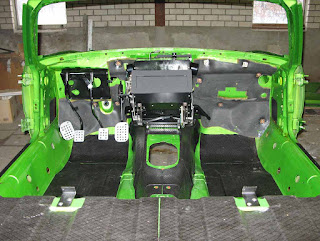The day before yesterday it was exactly one year ago that I started dismantling the DHC. Original plan was to do some body repairs (a little welding and removing lots of dents) and a complete new paint job. With the body of the car properly done, all other jobs could be done in the future, when the need for them arose. But pretty early in the project I realised that the work on the body would take longer. It turned out to be rather difficult to find decent craftsman, able enough (and willing) to do a proper job. So to kill some time while “headhunting”, I started cleaning and coating various bits of the car. So what started as a body only job, turned into a full restoration.
In the past year quite a lot of work has been carried out, which is illustrated quite nicely by the following two pictures, The first one taken exactly one year ago, the other is from today 😜
Over the past few day I have again busied myself with various little jobs that I am pulling forward as access to them is much easier now the body is still fairly bare. Like the screen washer pump and the ignition module and coil;
Over the past few day I have again busied myself with various little jobs that I am pulling forward as access to them is much easier now the body is still fairly bare. Like the screen washer pump and the ignition module and coil;
But the emphasis in the past few days had been on the wiring loom. First the main loom was roughly put in place;
After that I put the rear loom in. Thought this would be straightforward but it wasn’t. First of all it is fairly cold so the wires are pretty stiff, making it difficult to tape it down properly. But this was sorted with the by now trusty old paint stripper and a bit of duct-tape;
Biggest problem turned out to be the middle section of the rear loom. One way or another it’s just too long, and as it was rather stiff it proved to be difficult to put it “away” in a tidy manner. But even that got sorted in the end. I know you won’t see any of it ones the car is ready, but I just want to get it right. It took me longer than expected but I got to the boot in the end, to connect up the rear lights;
With the rear loom in place I switched to the door looms, in preparation for the doors to be fitted. While trying to fit these looms I found a new application for (long) cable ties. They are excellent to pull wiring through small inaccessible body holes, like those from interior light switches;
And to end the year René came over to help me with fitting the doors and the boot lid. Really starting to look like a car again. To be continued next year!











































